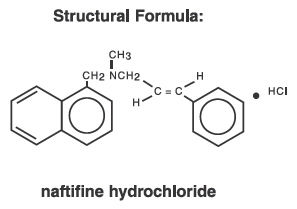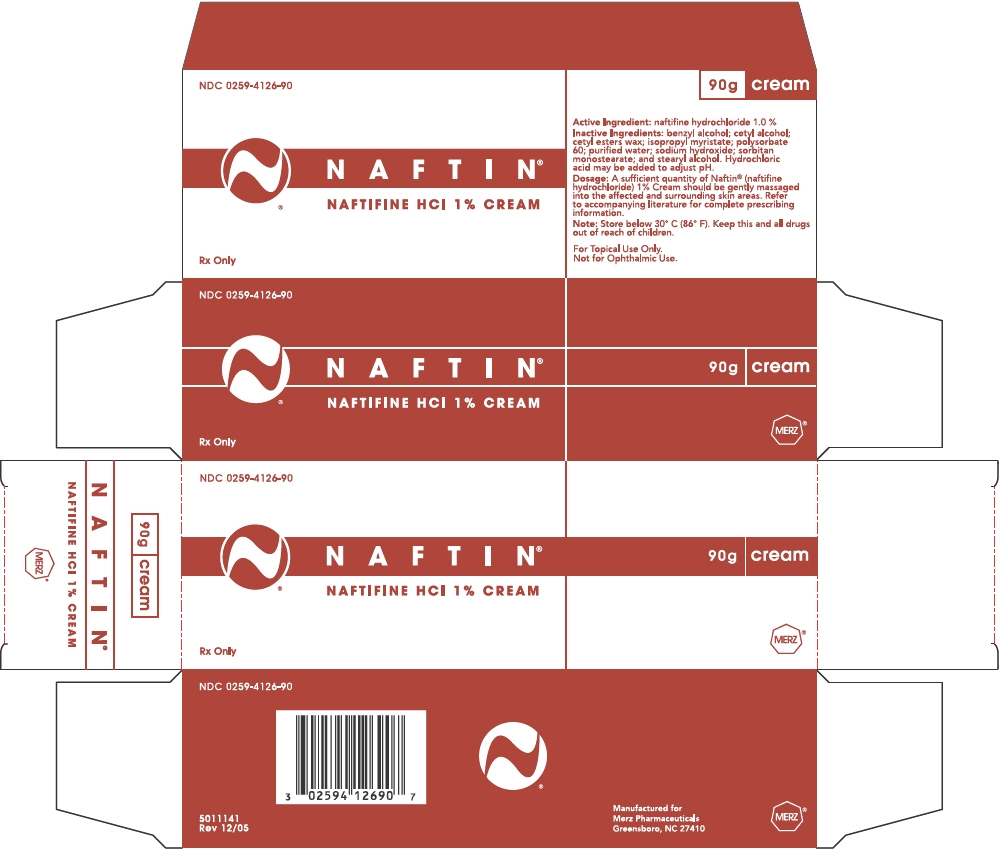NAFTIN- naftifine hydrochloride cream
Naftin by
Drug Labeling and Warnings
Naftin by is a Prescription medication manufactured, distributed, or labeled by Merz Pharmaceuticals, LLC. Drug facts, warnings, and ingredients follow.
Drug Details [pdf]
- SPL UNCLASSIFIED SECTION
-
DESCRIPTION
Naftin® Cream, 1% and Naftin® Gel, 1% contain the synthetic, broad-spectrum, antifungal agent naftifine hydrochloride. Naftin® Cream and Gel, 1% are for topical use only.
CHEMICAL NAME
(E)-N-Cinnamyl-N-methyl-1-naphthalenemethylamine hydrochloride. Naftifine hydrochloride has an empirical formula of C21H21NHCl and a molecular weight of 323.86.

Contains
Active Ingredient:
Naftifine hydrochloride.......... 1%.
Inactive Ingredients: Naftin® Cream, 1% contains benzyl alcohol, cetyl alcohol, cetyl esters wax, isopropyl myristate, polysorbate 60, purified water, sodium hydroxide, sorbitan monostearate, and stearyl alcohol. Hydrochloric acid may be added to adjust pH. Naftin® Gel, 1% contains polysorbate 80, carbomer 934P, diisopropanolamine, edetate disodium, alcohol (52%v/v), and purified water.
-
CLINICAL PHARMACOLOGY
Naftifine Hydrochloride is a synthetic allylamine derivative. The following in vitro data are available but their clinical significance is unknown. Naftifine hydrochloride has been shown to exhibit fungicidal activity in vitro against a broad spectrum of organisms, including Trichophyton rubrum, Trichophyton mentagrophytes, Trichophyton tonsurans, Epidermophyton floccosum, Microsporum canis, Microsporum audouini, and microsporum gypseum, and fungistatic activity against Candida species, including Candida albicans. Naftin® Cream and Gel, 1% have only been shown to be clinically effective against the disease entities listed in the INDICATIONS AND USAGE section.
Although the exact mechanism of action against fungi is not known, naftifine hydrochloride appears to interfere with sterol biosynthesis by inhibiting the enzyme squalene 2, 3-epoxidase. This inhibition of enzyme activity results in decreased amounts of sterols, especially ergosterol, and a corresponding accumulation of squalene in the cells.
Pharmacokinetics
In vitro and in vivo bioavailability studies have demonstrated that naftifine penetrates the stratum corneum in sufficient concentration to inhibit the growth of dermatophytes.
Following a single topical application of 1% of naftifine cream to the skin of healthy subjects, systemic absorption of naftifine was approximately 6% of the applied dose. Following single topical applications of 3H- labeled naftifine gel 1% to the skin of healthy subjects, up to 4.2% of the applied dose was absorbed. Naftifine and/or its metabolites are excreted via the urine and feces with a half-life of approximately two to three days.
-
INDICATIONS AND USAGE
Naftin® Cream, 1% is indicated for the topical treatment of tinea pedis, tinea cruris, and tinea corporis caused by the organisms Trichophyton rubrum, Trichophyton mentagrophytes, and Epidermophyton floccosum. Naftin® Gel, 1% is indicated for the topical treatment of tinea pedis, tinea cruris, and tinea corporis caused by the organisms Trichophyton rubrum, Trichophyton mentagrophytes, Trichophyton tonsurans1, Epidermophyton floccosum1.
- 1 Efficacy for this organism in this organ system was studied in fewer than 10 infections.
- CONTRAINDICATIONS
- WARNINGS
-
PRECAUTIONS
General
Naftin® Cream and Gel, 1%, are for external use only. If irritation or sensitivity develops with the use of Naftin® Cream or Gel, 1%, treatment should be discontinued and appropriate therapy instituted. Diagnosis of the disease should be confirmed either by direct microscopic examination of a mounting of infected tissue in a solution of potassium hydroxide or by culture on an appropriate medium.
Information for patients
The patient should be told to:
- Avoid the use of occlusive dressings or wrappings unless otherwise directed by the physician.
- Keep Naftin® Cream and Gel, 1% away from the eyes, nose, mouth and other mucous membranes.
Carcinogenesis, mutagenesis, impairment of fertility
Long-term studies to evaluate the carcinogenic potential of Naftin® Cream and Gel, 1% have not been performed. In vitro and animal studies have not demonstrated any mutagenic effect or effect on fertility.
Pregnancy
Teratogenic Effects
Pregnancy Category B
Reproduction studies have been performed in rats and rabbits (via oral administration) at doses 150 times or more than the topical human dose and have revealed no evidence of impaired fertility or harm to the fetus due to naftifine. There are, however, no adequate and well-controlled studies in pregnant women. Because animal reproduction studies are not always predictive of human response, this drug should be used during pregnancy only if clearly needed.
-
ADVERSE REACTIONS
During clinical trials with Naftin® Cream, 1%, the incidence of adverse reactions was as follows: burning/stinging (6%), dryness (3%), erythema (2%), itching (2%), local irritation (2%). During clinical trials with Naftin® Gel, 1%. the incidence of adverse reactions was as follows: burning Istinging (5.0%), itching (1.0%), erythema (0.5%), rash (0.5%), skin tenderness (0.5%).
-
DOSAGE AND ADMINISTRATION
A sufficient quantity of Naftin® Cream, 1% should be gently massaged into the affected and surrounding skin areas once a day. A sufficient quantity of Naftin® Gel, 1% should be gently massaged into the affected and surrounding skin areas twice a day, in the morning and evening. The hands should be washed after application. If no clinical improvement is seen after four weeks of treatment with Naftin® Cream or Gel, 1%, the patient should be re-evaluated.
-
HOW SUPPLIED
Naftin® (naftifine hydrochloride) Cream. 1% is supplied in collapsible tubes in the following sizes:
- 60g – NDC: 0259-4126-60
- 90g – NDC: 0259-4126-90
Naftin® (naftifine hydrochloride) Gel, 1% is supplied in collapsible tubes in the following sizes:
- 40g – NDC: 0259-4770-40
- 60g – NDC: 0259-4770-60
- 90g – NDC: 0259-4770-90
- SPL UNCLASSIFIED SECTION
- PRINCIPAL DISPLAY PANEL - 90g Tube Carton
-
INGREDIENTS AND APPEARANCE
NAFTIN
naftifine hydrochloride creamProduct Information Product Type HUMAN PRESCRIPTION DRUG Item Code (Source) NDC: 0259-4126 Route of Administration TOPICAL Active Ingredient/Active Moiety Ingredient Name Basis of Strength Strength NAFTIFINE HYDROCHLORIDE (UNII: 25UR9N9041) (NAFTIFINE - UNII:4FB1TON47A) NAFTIFINE HYDROCHLORIDE 10 mg in 1 g Inactive Ingredients Ingredient Name Strength Water (UNII: 059QF0KO0R) Isopropyl Myristate (UNII: 0RE8K4LNJS) Polysorbate 60 (UNII: CAL22UVI4M) Stearyl Alcohol (UNII: 2KR89I4H1Y) Cetyl Alcohol (UNII: 936JST6JCN) Cetyl Esters Wax (UNII: D072FFP9GU) Sorbitan Monostearate (UNII: NVZ4I0H58X) Benzyl Alcohol (UNII: LKG8494WBH) Product Characteristics Color WHITE Score Shape Size Flavor Imprint Code Contains Packaging # Item Code Package Description Marketing Start Date Marketing End Date 1 NDC: 0259-4126-02 10 in 1 CARTON 1 2 g in 1 TUBE 2 NDC: 0259-4126-60 1 in 1 CARTON 2 60 g in 1 TUBE 3 NDC: 0259-4126-90 1 in 1 CARTON 3 90 g in 1 TUBE Marketing Information Marketing Category Application Number or Monograph Citation Marketing Start Date Marketing End Date NDA NDA019599 06/01/1998 Labeler - Merz Pharmaceuticals, LLC (126209282)
Trademark Results [Naftin]
Mark Image Registration | Serial | Company Trademark Application Date |
|---|---|
 NAFTIN 73706755 not registered Dead/Abandoned |
THAMES PHARMACAL CO., INC. 1988-01-21 |
 NAFTIN 73589735 1412990 Live/Registered |
ALLERGAN PHARMACEUTICALS, INC. 1986-03-24 |
© 2025 FDA.report
This site is not affiliated with or endorsed by the FDA.
